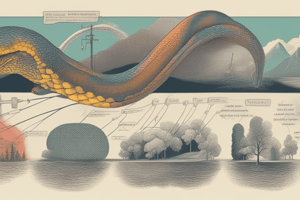Podcast
Questions and Answers
What is the purpose of variables in Python?
What is the purpose of variables in Python?
- Variables are used to store constant values in Python.
- Variables are used to define functions in Python.
- Variables are used to store data of different data types in Python. (correct)
- Variables are used to perform mathematical operations in Python.
What is the correct way to define a function in Python?
What is the correct way to define a function in Python?
- Use the `def` keyword followed by the function name, parameters, and function code. (correct)
- Use the `procedure` keyword followed by the function name, parameters, and function code.
- Use the `function` keyword followed by the function name, parameters, and function code.
- Use the `create` keyword followed by the function name, parameters, and function code.
Which of the following is not a primary data type in Python?
Which of the following is not a primary data type in Python?
- Floating-point number
- Array (correct)
- String
- Integer
What is the purpose of a loop in Python?
What is the purpose of a loop in Python?
Which of the following is a valid way to assign a value to a variable in Python?
Which of the following is a valid way to assign a value to a variable in Python?
What is the purpose of a for loop in Python?
What is the purpose of a for loop in Python?
Which control flow statement in Python is used to handle multiple conditions?
Which control flow statement in Python is used to handle multiple conditions?
In Python, what does a while loop do?
In Python, what does a while loop do?
What is the purpose of an elif statement in Python?
What is the purpose of an elif statement in Python?
Which fundamental concept in Python involves defining reusable blocks of code?
Which fundamental concept in Python involves defining reusable blocks of code?
Study Notes
Python Fundamentals
In this article, we will discuss Python fundamentals, specifically covering variables, data types, functions, loops, and control flow.
Variables
In Python, variables serve as storage containers for storing data. Variables have dynamic typing, meaning the data type of a variable changes according to its current value. Python does not require explicit type declaration. Here's an example:
x = 5
print(x)
Output: 5
Data Types
Python supports four primary data types: integers, floating-point numbers, strings, and boolean values.
Integers
Integers are whole numbers without decimal points, such as 2, 3, etc.
Floating-point Numbers
Floating-point numbers represent real numbers with a decimal point, such as 3.14 or -2.5.
Strings
Strings are sequences of characters, enclosed in single or double quotes. Examples include "hello" or 'world'.
Boolean Values
Boolean values represent either True or False, indicating the truth value of a condition.
Functions
Functions in Python are self-contained, executable pieces of code that perform specific tasks. To define a function, you use the def keyword followed by the function name, parameters (optional), and the function code. Here's an example:
def greet(name):
print("Hello, " + name)
greet('John')
Output: "Hello, John"
Loops
Loops are used to execute a block of code repeatedly. Python has two types of loops: for and while. For loops iterate over a range or sequence of numbers, while while loops repeat a block of code until a certain condition is met.
Examples
Here's an example using a for loop:
for i in range(5):
print(i)
Output: 0 1 2 3 4
And here's an example using a while loop:
x = 0
while x < 5:
print(x)
x += 1
Output: 0 1 2 3 4
Control Flow
Control flow statements allow you to control the execution path based on conditions. Python supports if, elif, and else statements.
if x > 0:
print('x is positive')
elif x < 0:
print('x is negative')
else:
print('x is zero')
In summary, Python fundamentals include variables, data types, functions, loops, and control flow statements. Understanding these concepts will provide a strong foundation for further learning in this versatile programming language.
Studying That Suits You
Use AI to generate personalized quizzes and flashcards to suit your learning preferences.
Description
Explore the fundamentals of Python programming including variables, data types (integers, floating-point numbers, strings, boolean values), functions, loops (for and while), and control flow statements (if, elif, else). Enhance your Python skills with this comprehensive overview.



